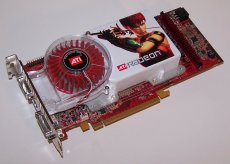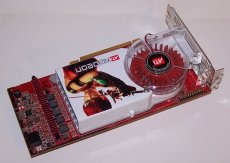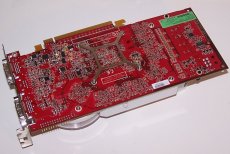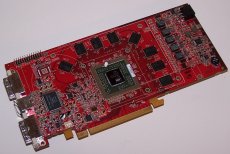The Boards
Moving on from the architectural details we'll take a look at the initial implementations of the R520 chip specifically with the Radeon X1800.
Radeon X1800 XT
Of the two Radeon X1800 configurations announced so far, the Radeon X1800 XT represents the highest performance board ATI are producing currently. The details of the board are as follows:
| Board Details | |
| Board Name | Radeon X1800 XT |
| Core Clock Rate | 625MHz |
| Pixel Pipelines | 16 |
| Pixel Fill-rate | 10000M Pixels/s |
| Texture Fill-rate | 10000M Texels/s |
| Geometry Processor | 8 VS |
| Geometry Rate | 1250M Triangles/s |
| Memory Speed | 750MHz |
| Memory Bandwidth | 48.0GB/s |
| Frame Buffer Size | 512MB |
| Host Interface | PCI Express x16 |
The Radeon X1800 XT board is somewhat of a behemoth. The PCB itself stands at 228mm long, which is some 41mm longer than the Radeon X850. The primary contributing factor to the different sizes is the power regulation circuitry that is on the back of the X1800 board. With a fairly large die running at 625MHz and 512MB of GDDR3 RAM running at 750MHz, a clean supply of power is certainly going to be critical to the operation of the board - unsurprisingly the board features an extra PCI Express for graphics power connector that augments the 75W supply from the PCI Express x16 slot directly from the PC's power supply.
The cooler used on the X1800 XT is similar in nature to that of the X850 XT's; it is a dual slot design that sucks air from the inside of the case, draws it over the core and blows the hotter air out the back. The primary difference in this design from the X850 XT is that the copper cooler area that is in direct contact with the core is larger, and also heat-pipes are used directly over the location of the core in order to spread the heat around the copper area more. The fan speeds are stepped according to the core temperatures with a number of ranges corresponding to a fan speed.
The layout of the memory is slightly reminiscent of NVIDIA's NV40/G70 and Matrox's Parhelia boards in that it arcs around the chip, distributing the 256-bit bus traces around more edges and allowing more flexibility in the traces to achieve high speeds; the layout on the X1800 XT differs from these boards by virtue of the fact that the chips are not ganged in groups of two due to the fact that the R520 chip doesn't use four 64-bit channels, requiring two of the 32-bit chips to be paired, but eight 32-bit channels. Once again it appears that Samsung is leading the way in high performance GDDR3 memories as the memory chips used by the X1800 XT are Samsungs K4J52324QC chips, using the newer 136 ball grid array packages with 512Mb densities - the board is running 8 chips for 512MB and with apparent spacing on the underside of the board it would appear that ATI would be able to support 1GB of graphics RAM. The memory chips are rated at 1.2ns, with a maximum specified operation of 800 MHz, which ATI are running 50MHz under - these are currently the highest rated speeds for GDDR3 from Samsung, so that extra 50MHz may come on a later product, although ATI are certainly encouraging memory manufactures to come on-stream with GDDR4 memories.
Courtesy of AVIVO, with its high level of integrated output capabilities, this is the first of ATI's consumer cards to support two Dual-DVI outputs, meaning the boards can drive two high resolution flat panels such as Apples 30" Cinema Display. The board also has Video-In/Video-Out capabilities with the integrated Xilleon TV encoder driving the TV-Output, and a Rage Theater chip handling the video input.











